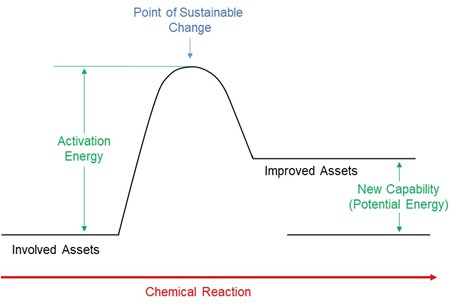Consulgetics™

Using science to move work forward and drive change is at the heart of the Consulgetics approach. It addresses two of the biggest challenges consultants face. How do we know what those are?
Whenever we deliver our consultant development workshops we ask the participants to list the biggest challenges in their daily work. Two things always make the list. First, they say they have trouble moving work forward. Progress stalls when clients don’t do what they’re supposed to do for the project, when needed resources aren’t available, or when obstacles get in the way. Second, they tell us that driving change in their client organizations, and their own, is difficult and, at times, seems impossible. For example, systems are implemented but people don’t fully adopt them, new processes are defined but people are more comfortable with the old way, or a faction of resisters has formed to undermine the whole effort.
If we could just solve these two problems, they say, life as a consultant would be so much better! And you know what? They’re right! Solving these problems is arguably a holy grail of consulting. But how do we do it?
First, we need to recognize that the way we’ve been approaching these problems simply isn’t working well. Then we need to find and adopt the new approaches that will give consultants the power and ability to meet these universal challenges. This article will give you a window into those approaches and a path to the details of using science to move work forward and drive change. Let’s take the challenges one at a time.
Using Science to Move Work Forward
When we boil it down to its root essence, consulting is all about energy. Everything we have ever done, and will ever do as consultants, is about energy. That’s a fact. Now, the question is, are you willing to think about it that way? If you are, you may be pleasantly surprised at the insights and new approaches that this perspective embodies. One thing that comes to light is that moving work forward is, at its root, no different than moving anything forward. Both are explained by the science of physics.
In physics movement is affected and determined by a number of factors. Things like mass, velocity, direction, momentum and inertia all come into play, and we have equations to both explain and predict movement. These same factors come into play in the movement of work, and all of these factors are related to energy. While I must avoid the details of that in this short article, I’ll cut to the chase.
 Your work moves forward when positive energy is applied in the direction of the desired outcome. Enough of that energy will bring your task/project/initiative to a successful conclusion. However, there are usually several factors at play, namely people (stakeholders and those involved in the work) and what we call enterprise elements (the organizational, operational and individual elements of a company). Each of these factors either contributes positive energy that helps move your work forward, remains neutral, or generates negative energy that pushes the work back or off track. The net influence (energy) from all the involved factors combined determines the direction of the work, and whether it’s moving forward or not.
Your work moves forward when positive energy is applied in the direction of the desired outcome. Enough of that energy will bring your task/project/initiative to a successful conclusion. However, there are usually several factors at play, namely people (stakeholders and those involved in the work) and what we call enterprise elements (the organizational, operational and individual elements of a company). Each of these factors either contributes positive energy that helps move your work forward, remains neutral, or generates negative energy that pushes the work back or off track. The net influence (energy) from all the involved factors combined determines the direction of the work, and whether it’s moving forward or not.
Managing Energy
This means that if you want your work to move forward you must make sure the Energy Equation adds up to a positive number. That’s not to say that we need to start applying physics equations in our consulting. We’re not at the point of measurement yet. However, we can look at the relative magnitudes of the energies involved to help us plan, monitor and manage our work.
A good example of how to do this is the practice of Engage, Align, Execute to move any kind of work forward.
- The Engage step is about bringing together the involved people and enterprise elements so they are part of the conversation. In a sense we are corralling the assets that will generate energy affecting our work.
- The Align step is to work with the people to align their goals, attitudes, behaviors, and energies regarding the work. We also analyze the involved enterprise elements to determine their role in achieving the desired outcome. In this way we’re bringing the involved energies together and pointing them in the same direction to create a much larger collective energy that will push the work forward.
- And, finally, the Execute step becomes an easier and more successful process as we implement the plan that we agreed on, now with the positive force of the collective and aligned energies behind our work. That’s managing energy to move work forward.
When people get stuck, they generally aren’t managing the energy. The most common mistake is to jump into Execute without first marshalling the collective energies of the involved people by applying the Engage and Align steps. It’s all about energy – and physics. Of course, there is much more detail regarding how you do this in different work situations, but you now have a window into this new approach.
Organizational Change is Chemistry
Whereas moving work forward is explained through physics, driving organizational change is more about the science of chemistry. The reason for that is that rather than being about the simple movement of things, organizational change is about the transformation of assets. The involved assets, as discussed above, are the people and the enterprise elements. With people, the transformation from one state to another is about changing opinions, beliefs, motivations and, ultimately, behaviors. With enterprise elements (e.g., processes, decision criteria, role definitions, etc.) the transformation is in augmenting or redesigning the elements to be what they need to be to support the new operational vision. In both cases we’re talking about a state change. That’s what happens in a chemical reaction.
Using Science to Drive Organizational Change
To show you how that works and how it applies to organizational change, the diagram below illustrates a chemical reaction. For those of you who actually remember things you learned in chemistry class, you may recognize this as an endothermic reaction. For the rest of you, don’t worry. You just need to understand the basic concept, which I will explain here.
 As illustrated in the diagram, the chemical reaction starts by combining the involved assets. In chemistry that’s usually different chemicals. In business, it’s the people and enterprise assets. Then we apply activation energy, which in chemistry often comes in the form of heat. (Picture me as a 10-year-old mixing random chemicals from my Dad’s old chemistry set and then heating the mixture over a Bunsen burner. Something is bound to happen. And it did.) In business much of this activation energy is directed toward the involved assets during the Engage and Align steps. This typically comes in the form of conversations, brainstorming sessions, interviews, etc. to get people on the same page.
As illustrated in the diagram, the chemical reaction starts by combining the involved assets. In chemistry that’s usually different chemicals. In business, it’s the people and enterprise assets. Then we apply activation energy, which in chemistry often comes in the form of heat. (Picture me as a 10-year-old mixing random chemicals from my Dad’s old chemistry set and then heating the mixture over a Bunsen burner. Something is bound to happen. And it did.) In business much of this activation energy is directed toward the involved assets during the Engage and Align steps. This typically comes in the form of conversations, brainstorming sessions, interviews, etc. to get people on the same page.
However we do it, we need enough activation energy to reach the point of sustainable change which, in business, is indicated by the involved people exhibiting the desired behaviors (e.g., they have fully adopted a new system). Until the point of sustainable change is reached, there is not sufficient asset change to be sustainable. Absent enough energy, things typically drift back down the left side of the curve into status quo. Conversely, once it does reach that transformational point, the assets settle into an improved state with new capability and capacity (i.e., higher potential for improved performance – the desired state). That’s when we really start seeing the return on investment.
A New Perspective
This equation curve explains a lot of things, including the one reason so many change initiatives still fail. Change initiatives fail because they run out of energy before they reach the finish line, the point of sustainable change. There are a variety of things that can erode or block an initiative’s activation energy, but there is only one reason they fail. They simply don’t have enough energy to “get over the hump.”

Why is all of this so important? Well, I’m sure you’ve heard the expression, “Keep your eye on the ball.” Our first problem is that we haven’t been watching the right ball, which is energy. If the dynamics of energy determine the outcome of our work, why haven’t we been watching them? Generally speaking, it’s because we didn’t know we should be watching energy, but now we do. What have we been watching? My short answer would be we’ve been watching contributors and circumstances involved in the energy dynamic. But that’s like looking at individual pieces of a puzzle, and perhaps the wrong puzzle at that.
If you can’t see the big picture you really don’t know where you are and where you’re going. Where you’re going is always the point of sustainable change. You know you’ve reached that point when you see the desired new behaviors of the involved people. How do you get there? Manage the energy. If your project is in jeopardy, manage the energy. If you want to keep your project out of jeopardy, manage the energy.
For More Information
My goal in this article is to help you understand the basic concepts of using science to move work forward and drive change. I want to help you see that there is a more direct way of managing that which will determine the success or failure of your projects. From that basis, if you’re interested in finding out how you and your team can learn the tools and techniques to put this approach into practice, Contact Us. We’ll set up a meeting to hear about your needs and challenges, and discuss options for a customized Consulgetics™ workshop.
